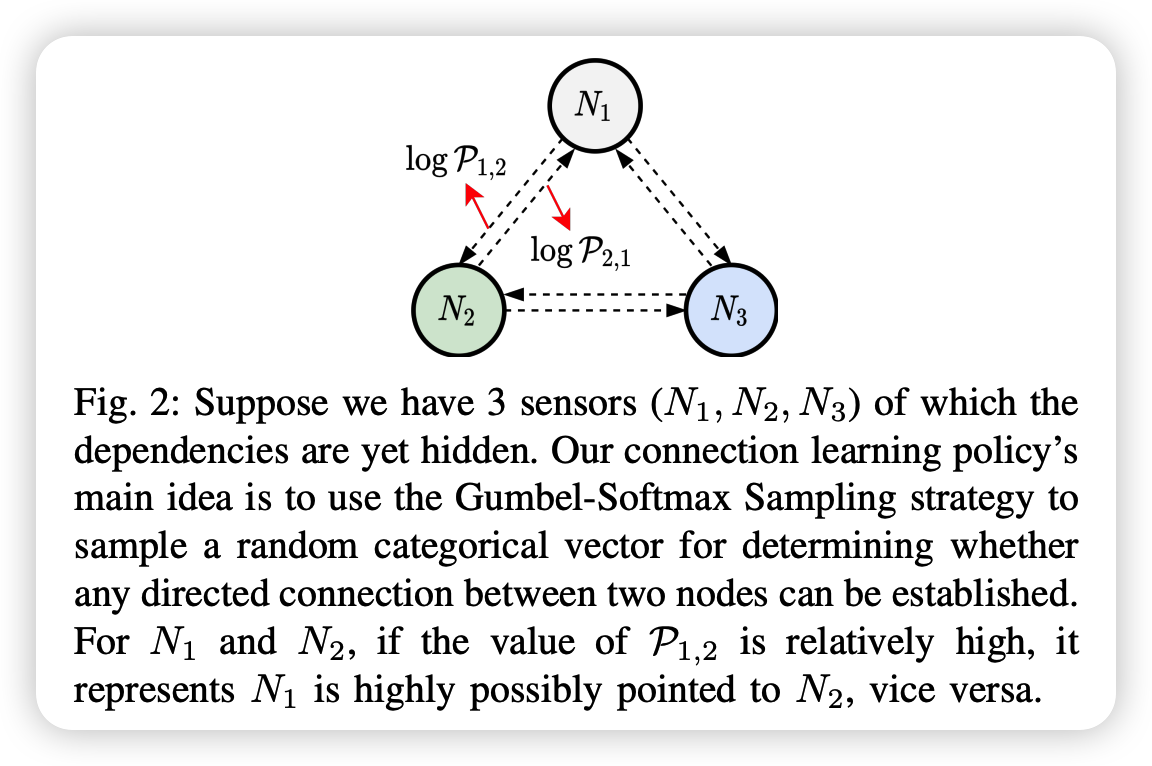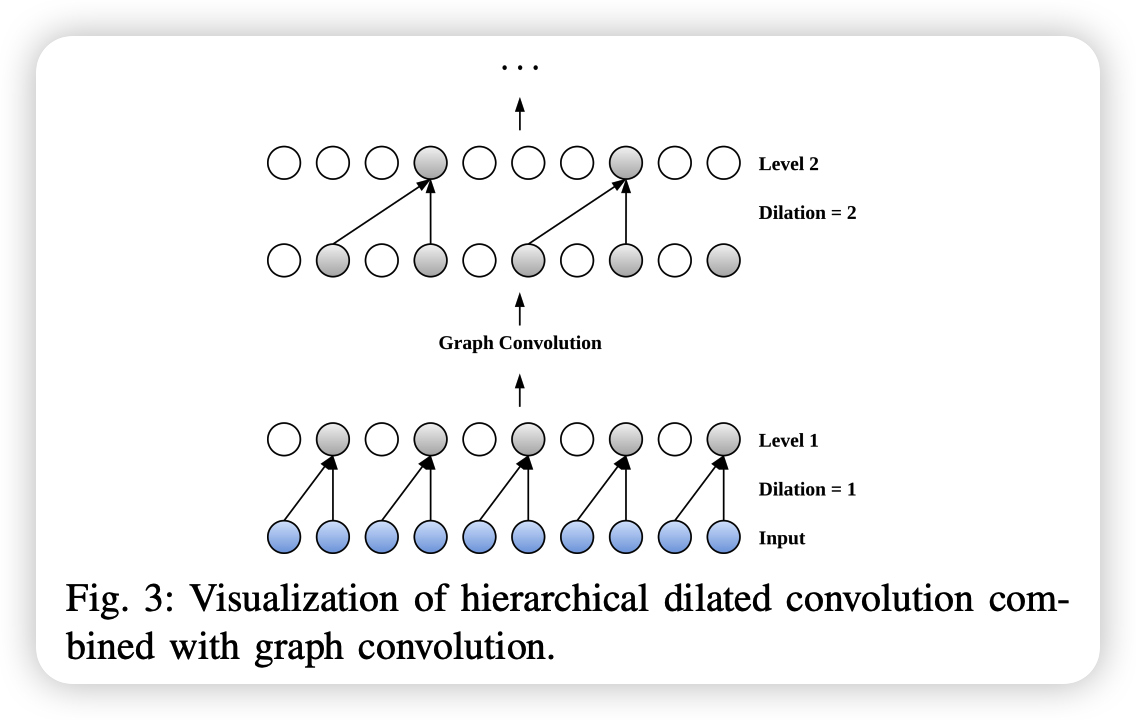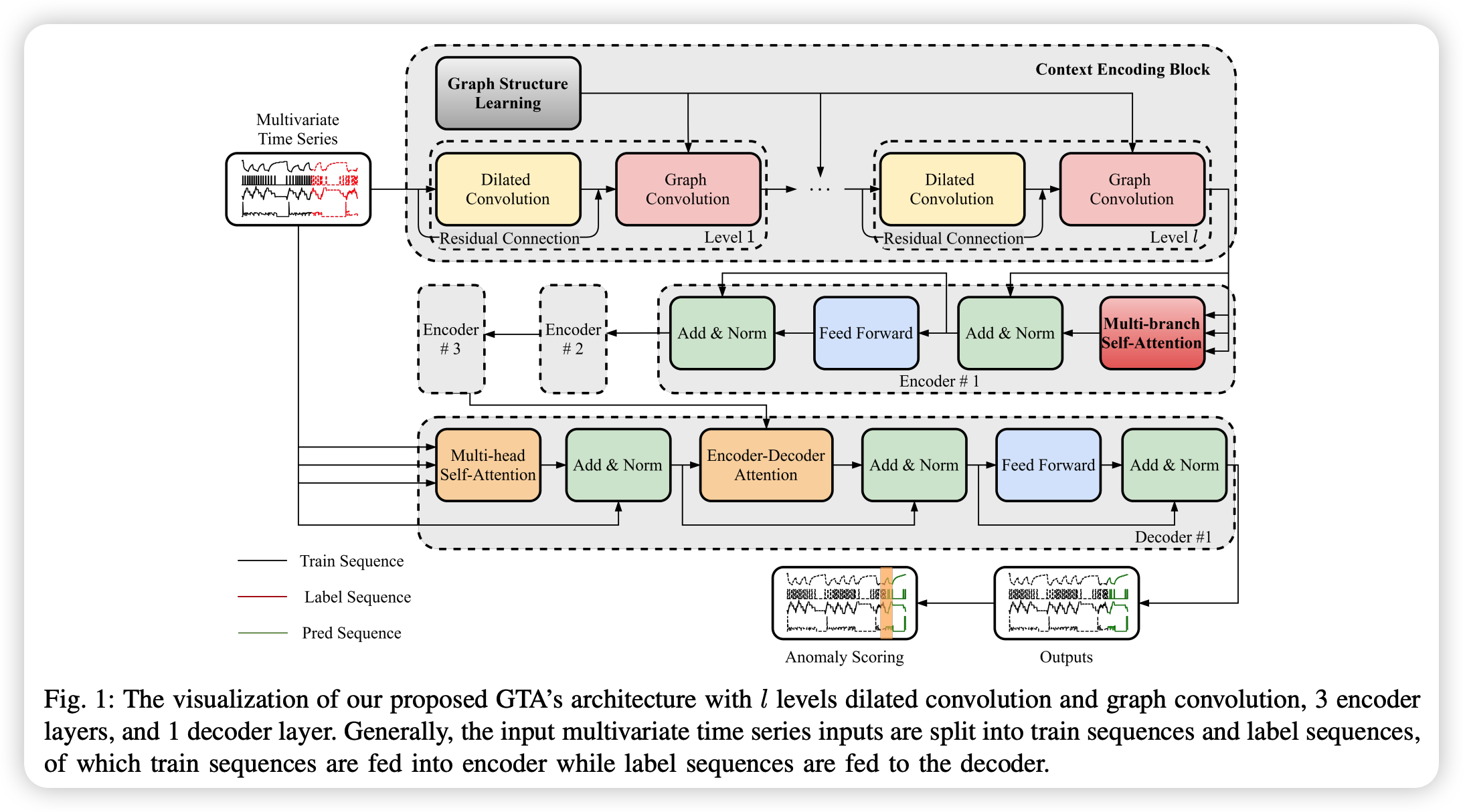Learning Graph Structures with Transformer for MTS Anomaly Detection in IoT (2022)
Contents
- Abstract
- Introduction
- Problem Statement
- Methodology
- Gumbel-Softmax Sampling
- Influence Propagation via Graph Convolution
- Hierarchical Dilated Convolution
- More Efficient Multi-branch Transformer
0. Abstract
Detecting anomaly in MTS
- difficult, due to temporal dependency & stochasticity
GTA
- new framework for MTS anomaly detection
- automatically learning a graph structure, graph convolution, modeling temporal dependency using Transformer
- connection learning policy
- based on Gumbel-softmax sampling
- learn bi-directed links among sensors
- Influence Propagation convolution
- anomaly information flow between nodes
1. Introduction
Existing GNN approaches
- use cosine similarity to learn the graph structure
- then, define top-K closest nodes as the source nodes’ connections
- then, do GAT
Problem with previous works?
- (1) dot products among sensor embeddings lead inevitably to QUADRATIC TIME & SPACE complexity, regarding the number of sensors
- (2) the TIGHTNESS of spatial distance can not entirely indicate that there exists a string connection in a topological structure
propose GTA (Graph learning with Transformer for Anomaly detection)
- learning a global bi-directed graph
- through a connection learning policy ( based on Gumbel Softmax Sampling )
- to overcome quadratic complexity & limitations of top-K nearest strategy
Transformer vs RNN
- Parallizeable!
Contribution
-
novel & differentiable connection learning policy
-
novel graph convolution ( = Information Propagation convolution ),
to model the anomaly influence flowing process
-
propose a novel multi-branch attention,
to tackle the original multi-head attention & quadratic complexity challenge
2. Problem Statement
Notation
- \(\mathcal{X}^{(t)} \in \mathbb{R}^{M}\) : MTS
- \(M\) : total number of sensors
- \(\mathcal{X}\) : normal data
- \(\hat{\mathcal{X}}\) : data with anomalies
only construct the sequence modeling process on normal data ( without anomalies )
Forecasting-based strategy
( single-step time series forecasting )
- target : predict the time series value \(\mathbf{x}^{(t)} \in \mathbb{R}^{M}\)
- input : \(\mathbf{x}=\left\{\mathbf{x}^{(t-n)}, \cdots, \mathbf{x}^{(t-1)}\right\}\)
- window size = \(n\)
Anomaly detection
- goal of AD : predict the output vector \(\hat{\mathbf{y}} \in \mathbb{R}^{n}\), where \(\hat{\mathbf{y}}^{(t)} \in\{0,1\}\)
- Returns an anomaly score for each testing timestamp
Definition :
- Graph : \(\mathcal{G}=(\mathcal{V}, \mathcal{E})\)
- \(\mathcal{V}=\{1, \cdots, M\}\) : set of nodes
- \(\mathcal{E} \subseteq \mathcal{V} \times \mathcal{V}\) : set of edges
- Node Neighborhood : \(\mathcal{N}(i)=\left\{j \in \mathcal{V} \mid \mathbf{e}_{i, j} \in \mathcal{E}\right\}\)
3. Methodology
Each sensor = specific node in the graph
-
previous methods : pick top-K closest node as neighbor
-
proposal : devise a directed graph structure learning policy,
to automatically learn the adjacency matrix!

Core of learning policy = Gumbel-softmax Sampling strategy
- inspired by policy learning network in RL
- discovered hidden associations are fed into GCN
Construct a hierarchical context encoding block
(1) Gumbel-Softmax Sampling
Sampling DISCRETE data …. non-differentiable!
\(\rightarrow\) introduce Gumbel softmax distn
( = continuous distn over the simplex….approximate samples from categorical distn )
Gumbel-Max trick
Sample any pair of nodes’ connection strategy \(z^{i, j} \in\{0,1\}^{2}\), with…
- \(z^{i, j}=\underset{c \in\{0,1\}}{\arg \max }\left(\log \pi_{c}^{i, j}+g_{c}^{i, j}\right)\).
- where \(g_{0}, g_{1}\) are i.i.d samples drawn from a standard Gumbel distribution
Gumbel-Softmax trick
Sample any pair of nodes’ connection strategy \(z^{i, j} \in\{0,1\}^{2}\), with…
- \(z_{c}^{i, j}=\frac{\exp \left(\left(\log \pi_{c}^{i, j}+g_{c}^{i, j}\right) / \tau\right)}{\sum_{v \in\{0,1\}} \exp \left(\left(\log \pi_{v}^{i, j}+g_{v}^{i, j}\right) / \tau\right)}\).
- \(\tau\) : temperature ( control smoothness )
proposed method significantly reduces the computation complexity
- \(\mathcal{O}\left(M^{2}\right)\) to \(\mathcal{O}(1)\)
- (do not need dot product among high-dim node embeddings)
(2) Influence Propagation via Graph Convolution
GCN block
- model the influence propagation process
Anomaly detection
-
occurrence of abnormalities is due to a series of chain influences,
caused by one/several nodes being attacked
IP (Influence Propagation)
- applying a node-wise symmetric aggregationg operation \(\square\)
- updated output of IPConv at \(i\)-th node :
- \(\mathbf{x}_{i}^{\prime}=\sum_{j \in \mathcal{N}(i)} h_{\Theta}\left(\mathbf{x}_{i} \mid \mid \mathbf{x}_{j}-\mathbf{x}_{j} \mid \mid \mathbf{x}_{j}+\mathbf{x}_{i}\right)\).
- \(\mathbf{x}_{j}-\mathbf{x}_{i}\) : differences between nodes to explicitly model the influence propagation delay from node \(j\) to \(i\)
Training Strategy & Regularization
-
propose a sparsity regularization \(\mathcal{L_s}\) to enhance the compactness of each node,
by minimizing the log-likelihood of the probability of a connection
-
\(\mathcal{L}_{s}=\sum_{1 \leq i, j \leq M, i \neq j} \log \pi_{1}^{i, j}\),
(3) Hierarchical Dilated Convolution
Dilated Conv ( via 1D-conv )
\(\rightarrow\) choosing the right kernel size is challenging!
\(\rightarrow\) Propose a hierarchical dilated convolution learning strategy( + GCN )

Description
- [bottom layer] MTS input ( for some time \(t\) )
- [first layer block]
- dilated conv with dilation rate=1
- [GCN]
- [second layer block]
- dilated conv with dilation rate=2
Able to capture LONG-term temporal dependencies
(4) More Efficient Multi-branch Transformer

(5) Overall Architecture

